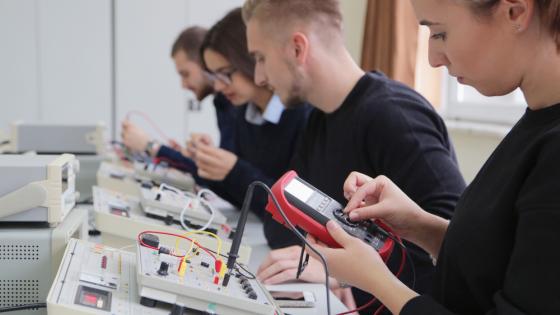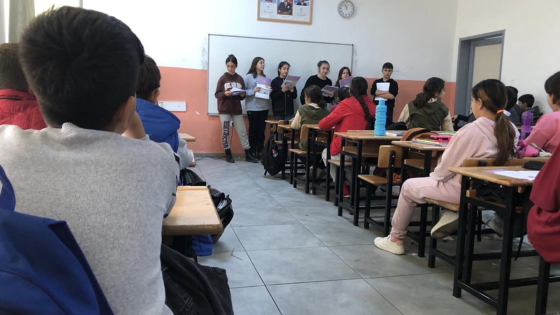Some countries – notably those which have long had a weak history of vocational education (like the UK and the US) – have recently seen a rapid expansion of hybrid schools, which provide both general and vocational education. Their introduction reflects a growing discontent with traditional two-sector systems that partition higher achieving students into ‘academic tracks’ and lower achieving students into ‘vocational tracks’. To move beyond this rigid dichotomy, the British government introduced University Technical Colleges (UTCs) in 2010. These new state-funded institutions (aimed at 14-18 year olds) were established with a very similar goal: combining academic and vocational education into a new type of hybrid institution. Their introduction in England coincides with a growing interest for career and technical education (CTE) in the US – new specialist schools that aim to equip students with employability skills, while rigorously teaching literacy and numeracy skills (Kreisman and Stange 2020).
The scope for education institutions like UTCs to remedy skill deficiencies and potential imbalances between academic and vocational routes is appealing to many. For example, a recent speech by the British Prime Minister Boris Johnson put the government’s skills policy agenda in the spotlight. Denouncing skills shortages in several technical occupations, the Prime Minister vowed to “end the pointless gulf between the so-called academic and the so-called practical varieties of education”. In our recently published research article we seek to understand whether UTCs have been successful at educating students and bridging the gap between academic and technical education.
UTCs were conceived as a response to a growing technical skills gap and to the perception that young people lacked adequate and engaging technical skills provision in secondary school. The cornerstone of these institutions is a teaching curriculum that blends core academic subjects with technical subjects that meet regional skill shortages (such as engineering, manufacturing, or digital technology). UTCs also benefit from the direct engagement of local universities and employers: industry experts help design and deliver project-based learning seeking to develop the skills and attributes valued in the workplace (Thorley 2017).
The first UTC opened in 2010, with 58 more subsequently opening in England. Despite this rapid expansion, over the years the UTC model has been dogged with controversy. One prominent feature is that some of their admissions occur at a non-conventional age of 14 (most education transitions to new schools in England occur at age 11, when pupils move from primary to secondary school). As new schools with no established record and a lack of publicity, the new colleges struggled to recruit enough students. Recruitment at age 14 proved particularly challenging as, typically, English students stay in the same secondary school between the age of 11 and 16 (whereas many move for their upper secondary education between age 16 and 18). Low operating capacity has dented the financial viability of a number of UTCs, resulting in 11 closing or changing status. They have also been criticised for their poor performance in national examinations (Dominguez-Reig and Robinson 2018, Thorley 2017). Part of this poor performance, however, might be due to the fact that UTC students look very different to typical students. In our study of the effectiveness of the colleges, we design an empirical strategy to take this factor into account.
Our research focuses on 30 UTCs that opened between 2010 and 2014. Having access to English education registry data linked to tax records, we are able to follow cohorts of students who enrolled in these colleges either in Year 10 (age 14) or Year 12 (age 16). For Year 10 entrants, we measure academic performance two years later in the high-stakes end-of-secondary school exams (GCSEs). For Year 12 entrants, we look at post-16 course choices, achievement at the end of upper-secondary education (age 18), and at whether students start an apprenticeship. We also look at students’ post-18 transition into Higher Education (whether they enrol in university and the subjects they chose) as well as their early labour market outcomes.
When comparing UTC and non-UTC students across a range of characteristics, they look remarkably different. The former are more likely to be male, white, and to speak English as a first language. These students are also less likely to come from a disadvantaged socio-economic background and they have, on average, lower standardised primary school test scores, particularly in English. Evening out these differences is crucial to avoid reaching biased conclusions on their effectiveness. To estimate the causal effect of University Technical Colleges on students’ achievements, we device a methodology that exploits two key determinants of students’ enrolment into UTCs: (1) the distance between a student’s home and the college (students living further away are less likely to enrol – see Figure 1) and (2) the time of opening of the UTCs (all these colleges are brand new schools which means that some cohorts of students were ineligible to enrol before their opening, while post-opening cohorts became eligible to enrol). We use the interaction between distance and cohort as an instrumental variable that exogenously shifts college enrolment.
Figure 1 Relationship between probability of enrolment and distance from UTC
We find striking differences in the effectiveness of University Technical Colleges for students who enter at age 14 (in Year 10) and those who enter at age 16 (in Year 12). For the first group, college enrolment has a very detrimental effect on end-of-secondary academic outcomes (GCSEs). Students who enrol in a UTC are 26 percentage points less likely to get five or more GCSEs with good grades (A*-C). This large negative effect is equivalent to doubling the achievement gap between disadvantaged and non-disadvantaged students in England. UTC enrolment also reduces students’ chances at achieving a good grade in English and Mathematics by 14 and six percentage points respectively. These results are concerning: Machin et al. (2020) show that missing out on this grade threshold in English reduces the probability of enrolling in upper-secondary and tertiary education by nine and four percentage points respectively, significantly limiting students’ progression over the longer term.
For Year 12 entrants, the effect of UTC enrolment is not as detrimental. Enrolment does not reduce students’ probability of achieving at least one academic qualification (A-Levels) and makes them much more likely to enter and achieve an equivalent technical qualification. We also find a strong effect on the probability of entering STEM qualifications (higher by 25 percentage points). Impressively, enrolling in a UTC increases students’ probability of starting an apprenticeship by 14 percentage points. This is a potentially very positive outcome: past evidence points to substantial apprenticeships payoffs for young people in England (Cavaglia et al. 2020).
Finally, we document positive effects of UTC enrolment up to one year after completing upper secondary education. While these colleges do not appear to be better (or worse) at sending students to university, they are very good at propelling students into STEM university degrees. Further, they enable the transition into the labour market: as a result of University Technical College enrolment in Year 12, students are three percentage points less likely to be NEETs (‘Not in Education, Employment, or Training’) one year after completing school.
What can explain these dramatically different results? One concern is that combining the academically demanding GCSE curriculum with additional technical subjects at a time where students are also adapting to a new school environment may prove too ambitious. Additionally, we find that Year 10 recruits are less academically able than Year 12 recruits (in terms of math sand English test scores) and this may compound the first issue, especially in light of our evidence that UTCs are better at teaching more academically able students. As some UTCs are shifting to recruit students at more natural transition point within the system (from age 14 to the historically conventional transition age 11), this might improve their performance to the extent that they become more attractive to higher-attaining students. In this case, colleges would also have more time to teach a broader curriculum before exams at age 16. More generally, we also need to bear in mind that University Technical Colleges are brand new schools and should not be judged too hastily. We find some evidence that University Technical Colleges might have improved after just one year. While the jury is still out on the longer-term effect of this policy, our study gives grounds for hope and offers insights for reforms. This is important for trying to address the future skills needs of the workforce and for redressing imbalances between academic and vocational education.
References
Cavaglia, C, S McNally and G Ventura (2020), “Do Apprenticeships Pay? Evidence for England”, Oxford Bulletin for Economics and Statistics (Wiley online library).
Dominguez-Reig, G and D Robinson (2018), “UTCs: Are They Delivering for Young People and the Economy?”, Education Policy Institute report.
House of Commons Library (2020), “University Technical Colleges”, Briefing Paper Number 07250.
Kreisman, D and K Stange (2020), “Vocational and Career Tech Education in American High Schools: The Value of Depth Over Breadth”, Education Finance and Policy 15(1): 11-44.
Machin, S, S McNally and J Ruiz-Valenzuela (2020), “Entry Through the Narrow Door: The Costs of Just Failing High Stakes Exams”, Journal of Public Economics 190.
Thorley, C (2017), “Tech Transitions. UTCs, Studio Schools and Technical and Vocational Education in England’s Schools”, Institute for Public Policy Research.








